Implications of Business Process Engineering
VerifiedAdded on 2023/06/03
|9
|2840
|76
AI Summary
This article discusses the positive impact of Business Process Engineering in changing business environments and the usefulness of automated workflows for monitoring and controlling business processes. It also highlights the success and failure factors of BPR.
Contribute Materials
Your contribution can guide someone’s learning journey. Share your
documents today.
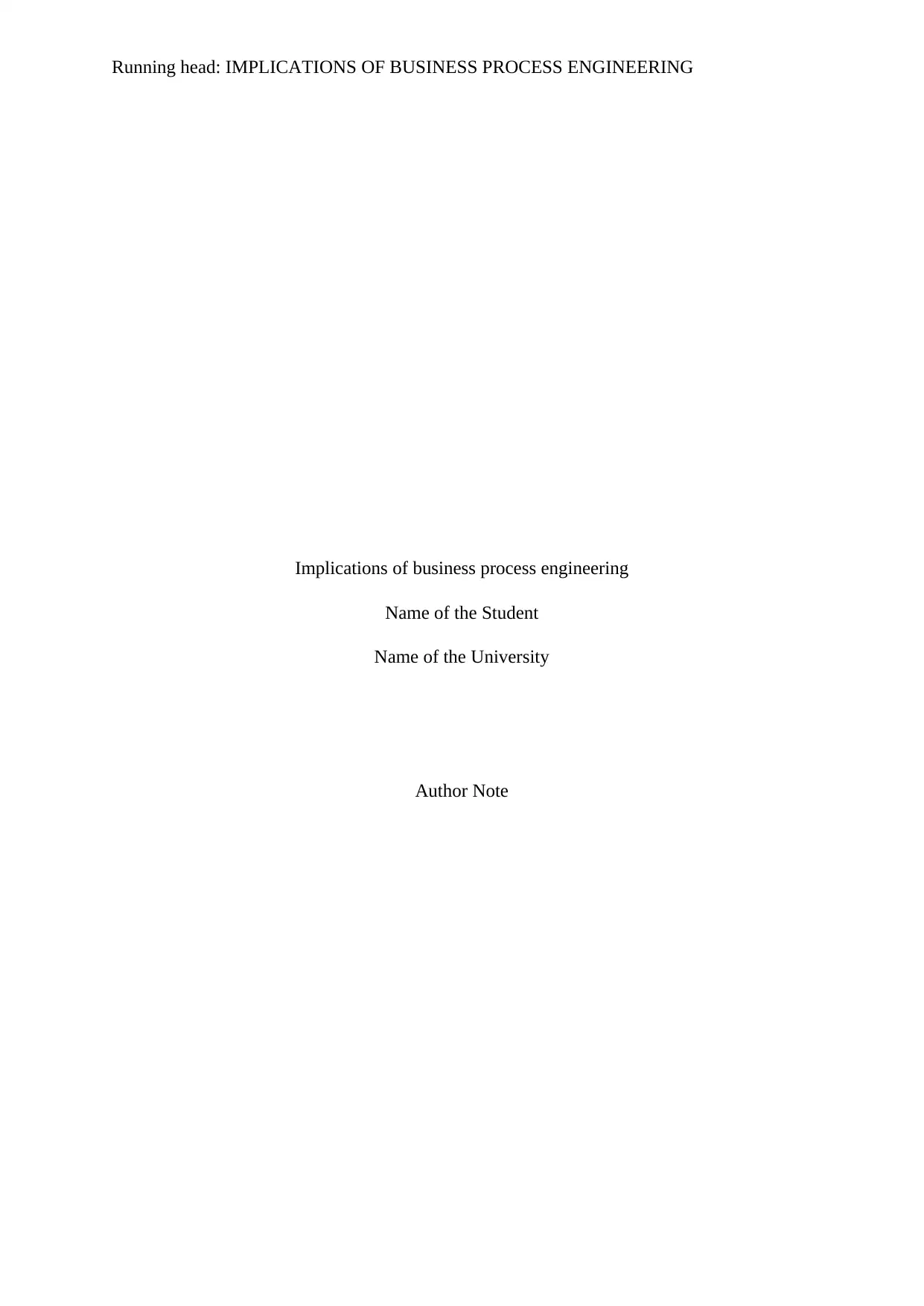
Running head: IMPLICATIONS OF BUSINESS PROCESS ENGINEERING
Implications of business process engineering
Name of the Student
Name of the University
Author Note
Implications of business process engineering
Name of the Student
Name of the University
Author Note
Secure Best Marks with AI Grader
Need help grading? Try our AI Grader for instant feedback on your assignments.

2IMPLICATIONS OF BUSINESS PROCESS ENGINEERING
Table of Contents
Introduction................................................................................................................................3
Discussion..................................................................................................................................3
Business Process Engineering and change in the business environments.............................3
Usefulness of automated workflows......................................................................................6
Conclusion..................................................................................................................................7
References..................................................................................................................................8
Table of Contents
Introduction................................................................................................................................3
Discussion..................................................................................................................................3
Business Process Engineering and change in the business environments.............................3
Usefulness of automated workflows......................................................................................6
Conclusion..................................................................................................................................7
References..................................................................................................................................8
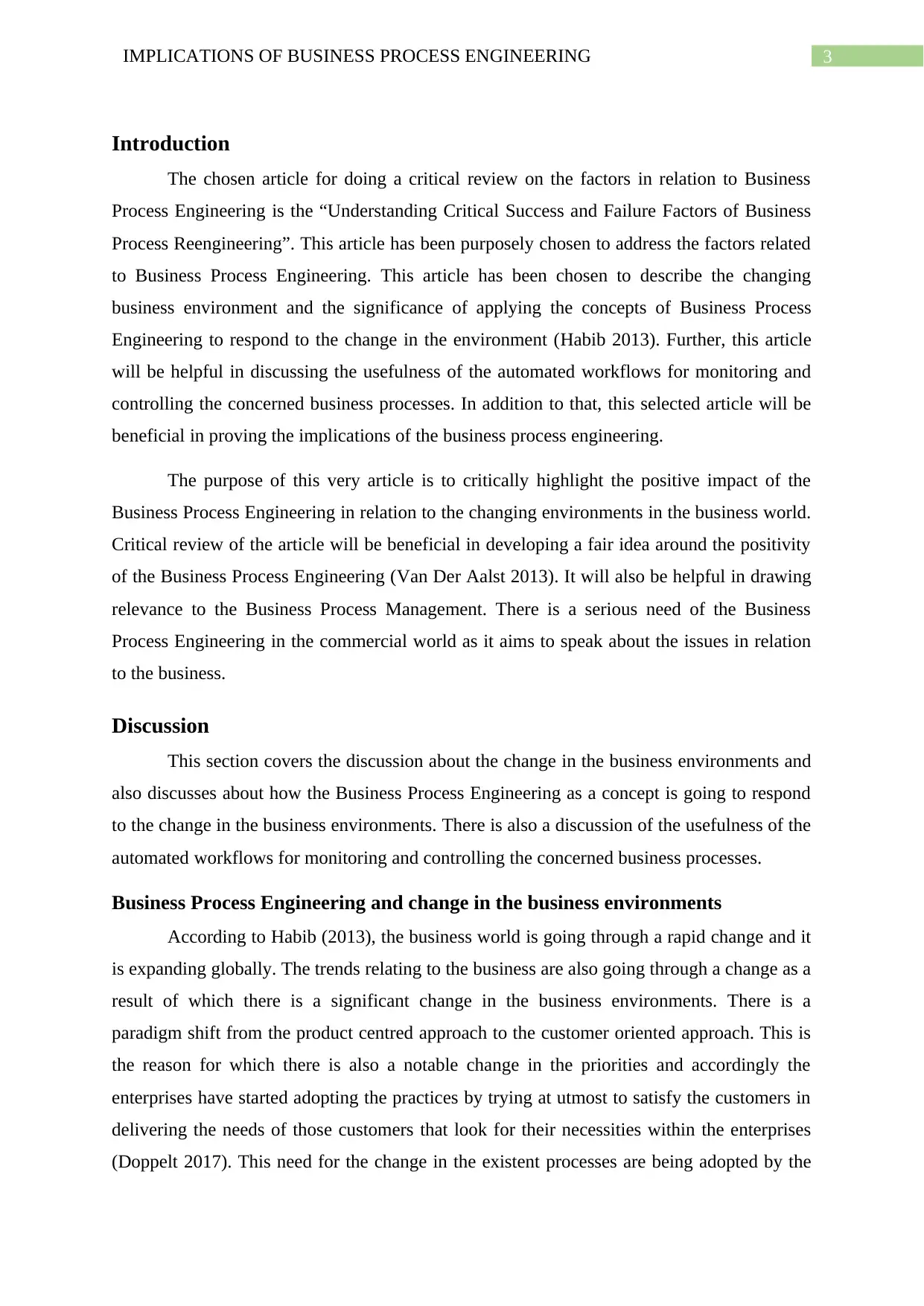
3IMPLICATIONS OF BUSINESS PROCESS ENGINEERING
Introduction
The chosen article for doing a critical review on the factors in relation to Business
Process Engineering is the “Understanding Critical Success and Failure Factors of Business
Process Reengineering”. This article has been purposely chosen to address the factors related
to Business Process Engineering. This article has been chosen to describe the changing
business environment and the significance of applying the concepts of Business Process
Engineering to respond to the change in the environment (Habib 2013). Further, this article
will be helpful in discussing the usefulness of the automated workflows for monitoring and
controlling the concerned business processes. In addition to that, this selected article will be
beneficial in proving the implications of the business process engineering.
The purpose of this very article is to critically highlight the positive impact of the
Business Process Engineering in relation to the changing environments in the business world.
Critical review of the article will be beneficial in developing a fair idea around the positivity
of the Business Process Engineering (Van Der Aalst 2013). It will also be helpful in drawing
relevance to the Business Process Management. There is a serious need of the Business
Process Engineering in the commercial world as it aims to speak about the issues in relation
to the business.
Discussion
This section covers the discussion about the change in the business environments and
also discusses about how the Business Process Engineering as a concept is going to respond
to the change in the business environments. There is also a discussion of the usefulness of the
automated workflows for monitoring and controlling the concerned business processes.
Business Process Engineering and change in the business environments
According to Habib (2013), the business world is going through a rapid change and it
is expanding globally. The trends relating to the business are also going through a change as a
result of which there is a significant change in the business environments. There is a
paradigm shift from the product centred approach to the customer oriented approach. This is
the reason for which there is also a notable change in the priorities and accordingly the
enterprises have started adopting the practices by trying at utmost to satisfy the customers in
delivering the needs of those customers that look for their necessities within the enterprises
(Doppelt 2017). This need for the change in the existent processes are being adopted by the
Introduction
The chosen article for doing a critical review on the factors in relation to Business
Process Engineering is the “Understanding Critical Success and Failure Factors of Business
Process Reengineering”. This article has been purposely chosen to address the factors related
to Business Process Engineering. This article has been chosen to describe the changing
business environment and the significance of applying the concepts of Business Process
Engineering to respond to the change in the environment (Habib 2013). Further, this article
will be helpful in discussing the usefulness of the automated workflows for monitoring and
controlling the concerned business processes. In addition to that, this selected article will be
beneficial in proving the implications of the business process engineering.
The purpose of this very article is to critically highlight the positive impact of the
Business Process Engineering in relation to the changing environments in the business world.
Critical review of the article will be beneficial in developing a fair idea around the positivity
of the Business Process Engineering (Van Der Aalst 2013). It will also be helpful in drawing
relevance to the Business Process Management. There is a serious need of the Business
Process Engineering in the commercial world as it aims to speak about the issues in relation
to the business.
Discussion
This section covers the discussion about the change in the business environments and
also discusses about how the Business Process Engineering as a concept is going to respond
to the change in the business environments. There is also a discussion of the usefulness of the
automated workflows for monitoring and controlling the concerned business processes.
Business Process Engineering and change in the business environments
According to Habib (2013), the business world is going through a rapid change and it
is expanding globally. The trends relating to the business are also going through a change as a
result of which there is a significant change in the business environments. There is a
paradigm shift from the product centred approach to the customer oriented approach. This is
the reason for which there is also a notable change in the priorities and accordingly the
enterprises have started adopting the practices by trying at utmost to satisfy the customers in
delivering the needs of those customers that look for their necessities within the enterprises
(Doppelt 2017). This need for the change in the existent processes are being adopted by the
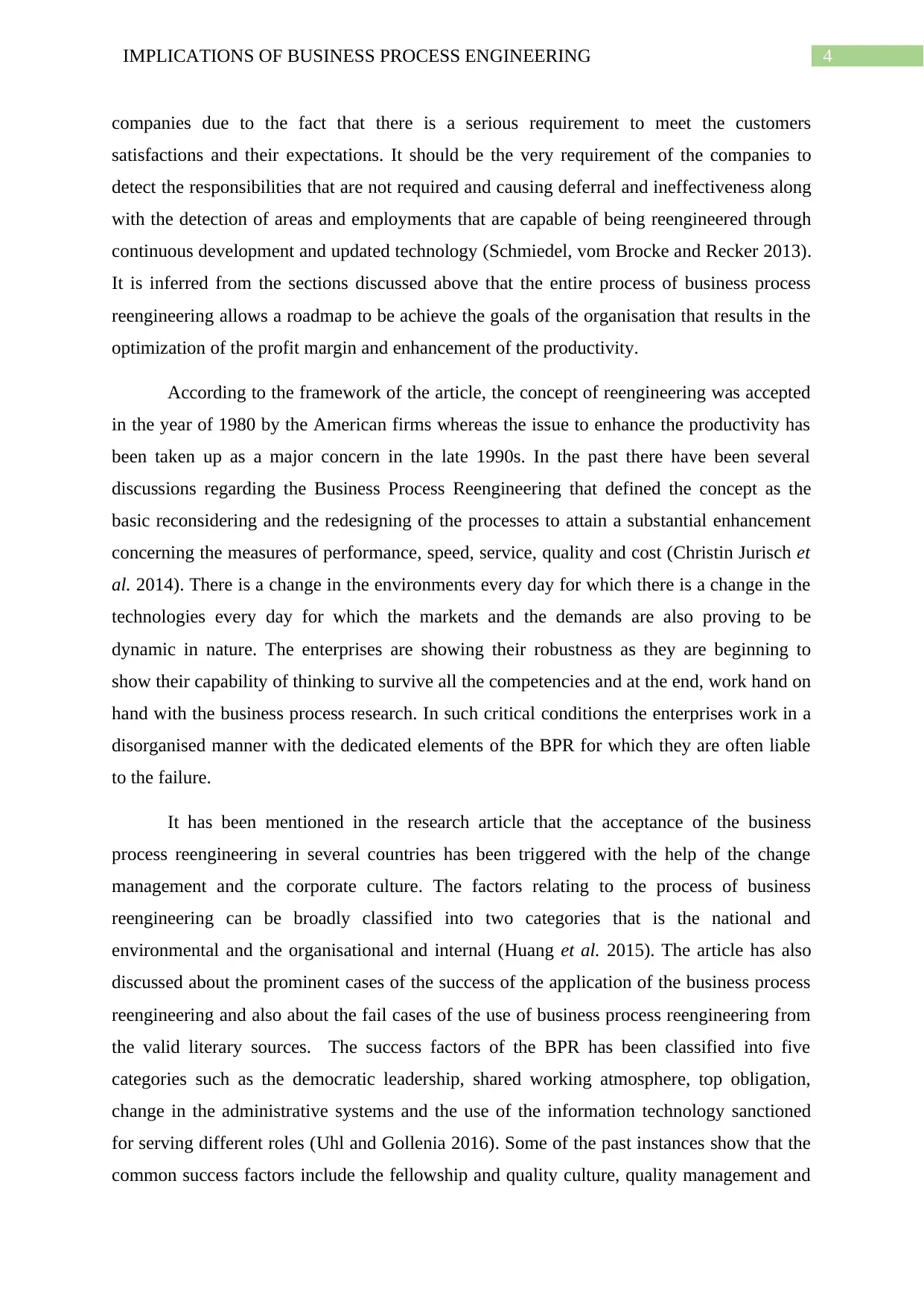
4IMPLICATIONS OF BUSINESS PROCESS ENGINEERING
companies due to the fact that there is a serious requirement to meet the customers
satisfactions and their expectations. It should be the very requirement of the companies to
detect the responsibilities that are not required and causing deferral and ineffectiveness along
with the detection of areas and employments that are capable of being reengineered through
continuous development and updated technology (Schmiedel, vom Brocke and Recker 2013).
It is inferred from the sections discussed above that the entire process of business process
reengineering allows a roadmap to be achieve the goals of the organisation that results in the
optimization of the profit margin and enhancement of the productivity.
According to the framework of the article, the concept of reengineering was accepted
in the year of 1980 by the American firms whereas the issue to enhance the productivity has
been taken up as a major concern in the late 1990s. In the past there have been several
discussions regarding the Business Process Reengineering that defined the concept as the
basic reconsidering and the redesigning of the processes to attain a substantial enhancement
concerning the measures of performance, speed, service, quality and cost (Christin Jurisch et
al. 2014). There is a change in the environments every day for which there is a change in the
technologies every day for which the markets and the demands are also proving to be
dynamic in nature. The enterprises are showing their robustness as they are beginning to
show their capability of thinking to survive all the competencies and at the end, work hand on
hand with the business process research. In such critical conditions the enterprises work in a
disorganised manner with the dedicated elements of the BPR for which they are often liable
to the failure.
It has been mentioned in the research article that the acceptance of the business
process reengineering in several countries has been triggered with the help of the change
management and the corporate culture. The factors relating to the process of business
reengineering can be broadly classified into two categories that is the national and
environmental and the organisational and internal (Huang et al. 2015). The article has also
discussed about the prominent cases of the success of the application of the business process
reengineering and also about the fail cases of the use of business process reengineering from
the valid literary sources. The success factors of the BPR has been classified into five
categories such as the democratic leadership, shared working atmosphere, top obligation,
change in the administrative systems and the use of the information technology sanctioned
for serving different roles (Uhl and Gollenia 2016). Some of the past instances show that the
common success factors include the fellowship and quality culture, quality management and
companies due to the fact that there is a serious requirement to meet the customers
satisfactions and their expectations. It should be the very requirement of the companies to
detect the responsibilities that are not required and causing deferral and ineffectiveness along
with the detection of areas and employments that are capable of being reengineered through
continuous development and updated technology (Schmiedel, vom Brocke and Recker 2013).
It is inferred from the sections discussed above that the entire process of business process
reengineering allows a roadmap to be achieve the goals of the organisation that results in the
optimization of the profit margin and enhancement of the productivity.
According to the framework of the article, the concept of reengineering was accepted
in the year of 1980 by the American firms whereas the issue to enhance the productivity has
been taken up as a major concern in the late 1990s. In the past there have been several
discussions regarding the Business Process Reengineering that defined the concept as the
basic reconsidering and the redesigning of the processes to attain a substantial enhancement
concerning the measures of performance, speed, service, quality and cost (Christin Jurisch et
al. 2014). There is a change in the environments every day for which there is a change in the
technologies every day for which the markets and the demands are also proving to be
dynamic in nature. The enterprises are showing their robustness as they are beginning to
show their capability of thinking to survive all the competencies and at the end, work hand on
hand with the business process research. In such critical conditions the enterprises work in a
disorganised manner with the dedicated elements of the BPR for which they are often liable
to the failure.
It has been mentioned in the research article that the acceptance of the business
process reengineering in several countries has been triggered with the help of the change
management and the corporate culture. The factors relating to the process of business
reengineering can be broadly classified into two categories that is the national and
environmental and the organisational and internal (Huang et al. 2015). The article has also
discussed about the prominent cases of the success of the application of the business process
reengineering and also about the fail cases of the use of business process reengineering from
the valid literary sources. The success factors of the BPR has been classified into five
categories such as the democratic leadership, shared working atmosphere, top obligation,
change in the administrative systems and the use of the information technology sanctioned
for serving different roles (Uhl and Gollenia 2016). Some of the past instances show that the
common success factors include the fellowship and quality culture, quality management and
Paraphrase This Document
Need a fresh take? Get an instant paraphrase of this document with our AI Paraphraser
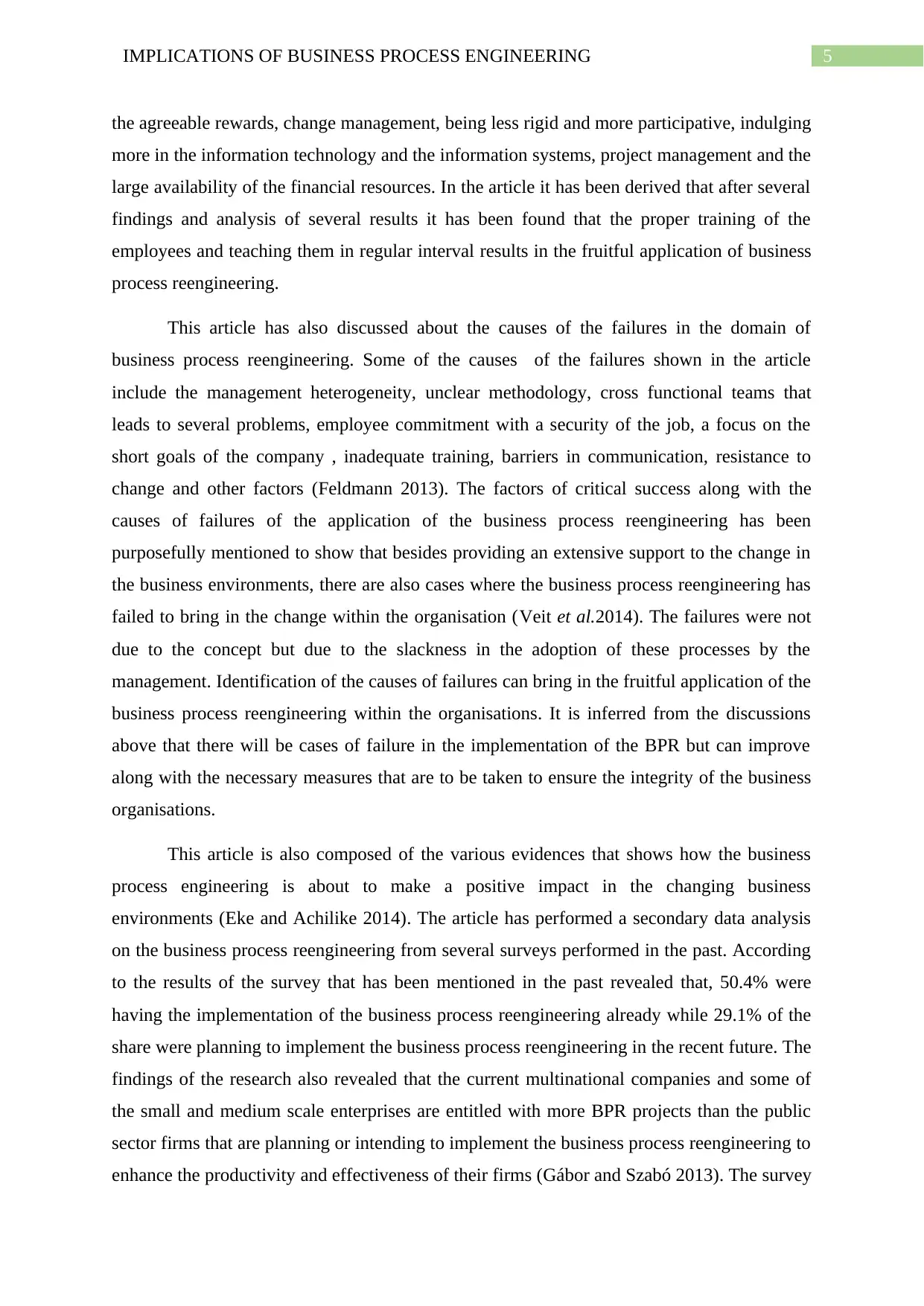
5IMPLICATIONS OF BUSINESS PROCESS ENGINEERING
the agreeable rewards, change management, being less rigid and more participative, indulging
more in the information technology and the information systems, project management and the
large availability of the financial resources. In the article it has been derived that after several
findings and analysis of several results it has been found that the proper training of the
employees and teaching them in regular interval results in the fruitful application of business
process reengineering.
This article has also discussed about the causes of the failures in the domain of
business process reengineering. Some of the causes of the failures shown in the article
include the management heterogeneity, unclear methodology, cross functional teams that
leads to several problems, employee commitment with a security of the job, a focus on the
short goals of the company , inadequate training, barriers in communication, resistance to
change and other factors (Feldmann 2013). The factors of critical success along with the
causes of failures of the application of the business process reengineering has been
purposefully mentioned to show that besides providing an extensive support to the change in
the business environments, there are also cases where the business process reengineering has
failed to bring in the change within the organisation (Veit et al.2014). The failures were not
due to the concept but due to the slackness in the adoption of these processes by the
management. Identification of the causes of failures can bring in the fruitful application of the
business process reengineering within the organisations. It is inferred from the discussions
above that there will be cases of failure in the implementation of the BPR but can improve
along with the necessary measures that are to be taken to ensure the integrity of the business
organisations.
This article is also composed of the various evidences that shows how the business
process engineering is about to make a positive impact in the changing business
environments (Eke and Achilike 2014). The article has performed a secondary data analysis
on the business process reengineering from several surveys performed in the past. According
to the results of the survey that has been mentioned in the past revealed that, 50.4% were
having the implementation of the business process reengineering already while 29.1% of the
share were planning to implement the business process reengineering in the recent future. The
findings of the research also revealed that the current multinational companies and some of
the small and medium scale enterprises are entitled with more BPR projects than the public
sector firms that are planning or intending to implement the business process reengineering to
enhance the productivity and effectiveness of their firms (Gábor and Szabó 2013). The survey
the agreeable rewards, change management, being less rigid and more participative, indulging
more in the information technology and the information systems, project management and the
large availability of the financial resources. In the article it has been derived that after several
findings and analysis of several results it has been found that the proper training of the
employees and teaching them in regular interval results in the fruitful application of business
process reengineering.
This article has also discussed about the causes of the failures in the domain of
business process reengineering. Some of the causes of the failures shown in the article
include the management heterogeneity, unclear methodology, cross functional teams that
leads to several problems, employee commitment with a security of the job, a focus on the
short goals of the company , inadequate training, barriers in communication, resistance to
change and other factors (Feldmann 2013). The factors of critical success along with the
causes of failures of the application of the business process reengineering has been
purposefully mentioned to show that besides providing an extensive support to the change in
the business environments, there are also cases where the business process reengineering has
failed to bring in the change within the organisation (Veit et al.2014). The failures were not
due to the concept but due to the slackness in the adoption of these processes by the
management. Identification of the causes of failures can bring in the fruitful application of the
business process reengineering within the organisations. It is inferred from the discussions
above that there will be cases of failure in the implementation of the BPR but can improve
along with the necessary measures that are to be taken to ensure the integrity of the business
organisations.
This article is also composed of the various evidences that shows how the business
process engineering is about to make a positive impact in the changing business
environments (Eke and Achilike 2014). The article has performed a secondary data analysis
on the business process reengineering from several surveys performed in the past. According
to the results of the survey that has been mentioned in the past revealed that, 50.4% were
having the implementation of the business process reengineering already while 29.1% of the
share were planning to implement the business process reengineering in the recent future. The
findings of the research also revealed that the current multinational companies and some of
the small and medium scale enterprises are entitled with more BPR projects than the public
sector firms that are planning or intending to implement the business process reengineering to
enhance the productivity and effectiveness of their firms (Gábor and Szabó 2013). The survey
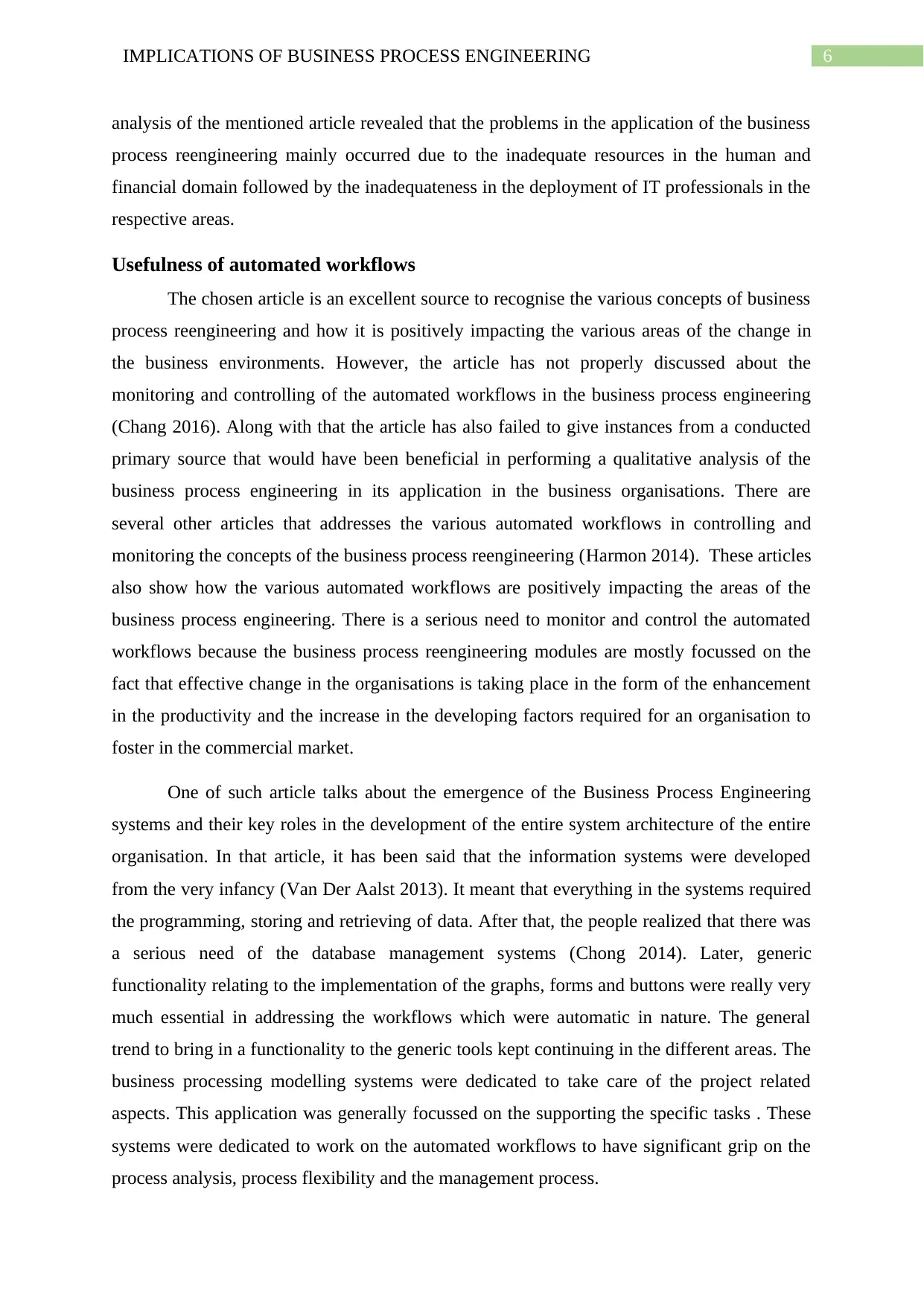
6IMPLICATIONS OF BUSINESS PROCESS ENGINEERING
analysis of the mentioned article revealed that the problems in the application of the business
process reengineering mainly occurred due to the inadequate resources in the human and
financial domain followed by the inadequateness in the deployment of IT professionals in the
respective areas.
Usefulness of automated workflows
The chosen article is an excellent source to recognise the various concepts of business
process reengineering and how it is positively impacting the various areas of the change in
the business environments. However, the article has not properly discussed about the
monitoring and controlling of the automated workflows in the business process engineering
(Chang 2016). Along with that the article has also failed to give instances from a conducted
primary source that would have been beneficial in performing a qualitative analysis of the
business process engineering in its application in the business organisations. There are
several other articles that addresses the various automated workflows in controlling and
monitoring the concepts of the business process reengineering (Harmon 2014). These articles
also show how the various automated workflows are positively impacting the areas of the
business process engineering. There is a serious need to monitor and control the automated
workflows because the business process reengineering modules are mostly focussed on the
fact that effective change in the organisations is taking place in the form of the enhancement
in the productivity and the increase in the developing factors required for an organisation to
foster in the commercial market.
One of such article talks about the emergence of the Business Process Engineering
systems and their key roles in the development of the entire system architecture of the entire
organisation. In that article, it has been said that the information systems were developed
from the very infancy (Van Der Aalst 2013). It meant that everything in the systems required
the programming, storing and retrieving of data. After that, the people realized that there was
a serious need of the database management systems (Chong 2014). Later, generic
functionality relating to the implementation of the graphs, forms and buttons were really very
much essential in addressing the workflows which were automatic in nature. The general
trend to bring in a functionality to the generic tools kept continuing in the different areas. The
business processing modelling systems were dedicated to take care of the project related
aspects. This application was generally focussed on the supporting the specific tasks . These
systems were dedicated to work on the automated workflows to have significant grip on the
process analysis, process flexibility and the management process.
analysis of the mentioned article revealed that the problems in the application of the business
process reengineering mainly occurred due to the inadequate resources in the human and
financial domain followed by the inadequateness in the deployment of IT professionals in the
respective areas.
Usefulness of automated workflows
The chosen article is an excellent source to recognise the various concepts of business
process reengineering and how it is positively impacting the various areas of the change in
the business environments. However, the article has not properly discussed about the
monitoring and controlling of the automated workflows in the business process engineering
(Chang 2016). Along with that the article has also failed to give instances from a conducted
primary source that would have been beneficial in performing a qualitative analysis of the
business process engineering in its application in the business organisations. There are
several other articles that addresses the various automated workflows in controlling and
monitoring the concepts of the business process reengineering (Harmon 2014). These articles
also show how the various automated workflows are positively impacting the areas of the
business process engineering. There is a serious need to monitor and control the automated
workflows because the business process reengineering modules are mostly focussed on the
fact that effective change in the organisations is taking place in the form of the enhancement
in the productivity and the increase in the developing factors required for an organisation to
foster in the commercial market.
One of such article talks about the emergence of the Business Process Engineering
systems and their key roles in the development of the entire system architecture of the entire
organisation. In that article, it has been said that the information systems were developed
from the very infancy (Van Der Aalst 2013). It meant that everything in the systems required
the programming, storing and retrieving of data. After that, the people realized that there was
a serious need of the database management systems (Chong 2014). Later, generic
functionality relating to the implementation of the graphs, forms and buttons were really very
much essential in addressing the workflows which were automatic in nature. The general
trend to bring in a functionality to the generic tools kept continuing in the different areas. The
business processing modelling systems were dedicated to take care of the project related
aspects. This application was generally focussed on the supporting the specific tasks . These
systems were dedicated to work on the automated workflows to have significant grip on the
process analysis, process flexibility and the management process.
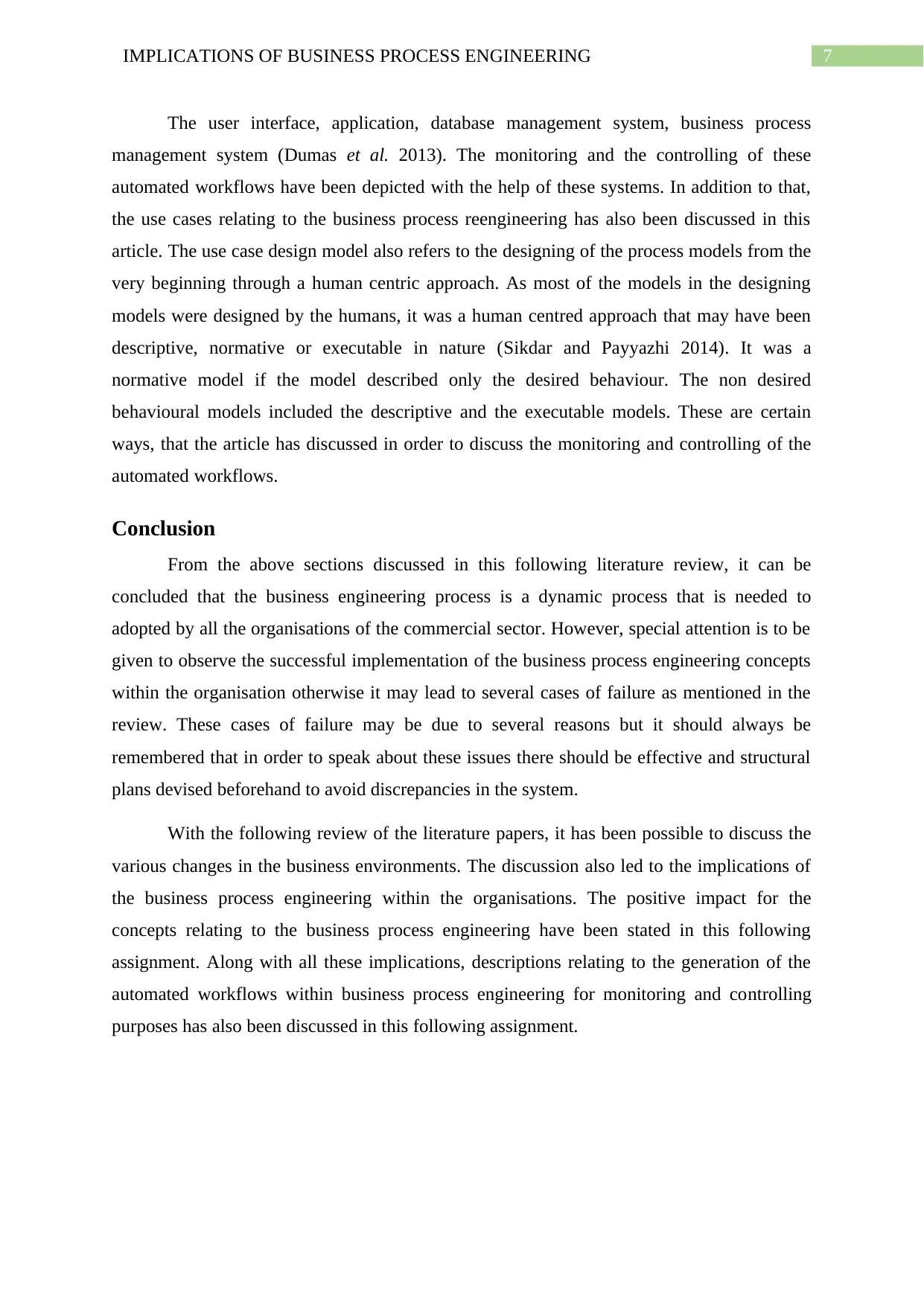
7IMPLICATIONS OF BUSINESS PROCESS ENGINEERING
The user interface, application, database management system, business process
management system (Dumas et al. 2013). The monitoring and the controlling of these
automated workflows have been depicted with the help of these systems. In addition to that,
the use cases relating to the business process reengineering has also been discussed in this
article. The use case design model also refers to the designing of the process models from the
very beginning through a human centric approach. As most of the models in the designing
models were designed by the humans, it was a human centred approach that may have been
descriptive, normative or executable in nature (Sikdar and Payyazhi 2014). It was a
normative model if the model described only the desired behaviour. The non desired
behavioural models included the descriptive and the executable models. These are certain
ways, that the article has discussed in order to discuss the monitoring and controlling of the
automated workflows.
Conclusion
From the above sections discussed in this following literature review, it can be
concluded that the business engineering process is a dynamic process that is needed to
adopted by all the organisations of the commercial sector. However, special attention is to be
given to observe the successful implementation of the business process engineering concepts
within the organisation otherwise it may lead to several cases of failure as mentioned in the
review. These cases of failure may be due to several reasons but it should always be
remembered that in order to speak about these issues there should be effective and structural
plans devised beforehand to avoid discrepancies in the system.
With the following review of the literature papers, it has been possible to discuss the
various changes in the business environments. The discussion also led to the implications of
the business process engineering within the organisations. The positive impact for the
concepts relating to the business process engineering have been stated in this following
assignment. Along with all these implications, descriptions relating to the generation of the
automated workflows within business process engineering for monitoring and controlling
purposes has also been discussed in this following assignment.
The user interface, application, database management system, business process
management system (Dumas et al. 2013). The monitoring and the controlling of these
automated workflows have been depicted with the help of these systems. In addition to that,
the use cases relating to the business process reengineering has also been discussed in this
article. The use case design model also refers to the designing of the process models from the
very beginning through a human centric approach. As most of the models in the designing
models were designed by the humans, it was a human centred approach that may have been
descriptive, normative or executable in nature (Sikdar and Payyazhi 2014). It was a
normative model if the model described only the desired behaviour. The non desired
behavioural models included the descriptive and the executable models. These are certain
ways, that the article has discussed in order to discuss the monitoring and controlling of the
automated workflows.
Conclusion
From the above sections discussed in this following literature review, it can be
concluded that the business engineering process is a dynamic process that is needed to
adopted by all the organisations of the commercial sector. However, special attention is to be
given to observe the successful implementation of the business process engineering concepts
within the organisation otherwise it may lead to several cases of failure as mentioned in the
review. These cases of failure may be due to several reasons but it should always be
remembered that in order to speak about these issues there should be effective and structural
plans devised beforehand to avoid discrepancies in the system.
With the following review of the literature papers, it has been possible to discuss the
various changes in the business environments. The discussion also led to the implications of
the business process engineering within the organisations. The positive impact for the
concepts relating to the business process engineering have been stated in this following
assignment. Along with all these implications, descriptions relating to the generation of the
automated workflows within business process engineering for monitoring and controlling
purposes has also been discussed in this following assignment.
Secure Best Marks with AI Grader
Need help grading? Try our AI Grader for instant feedback on your assignments.
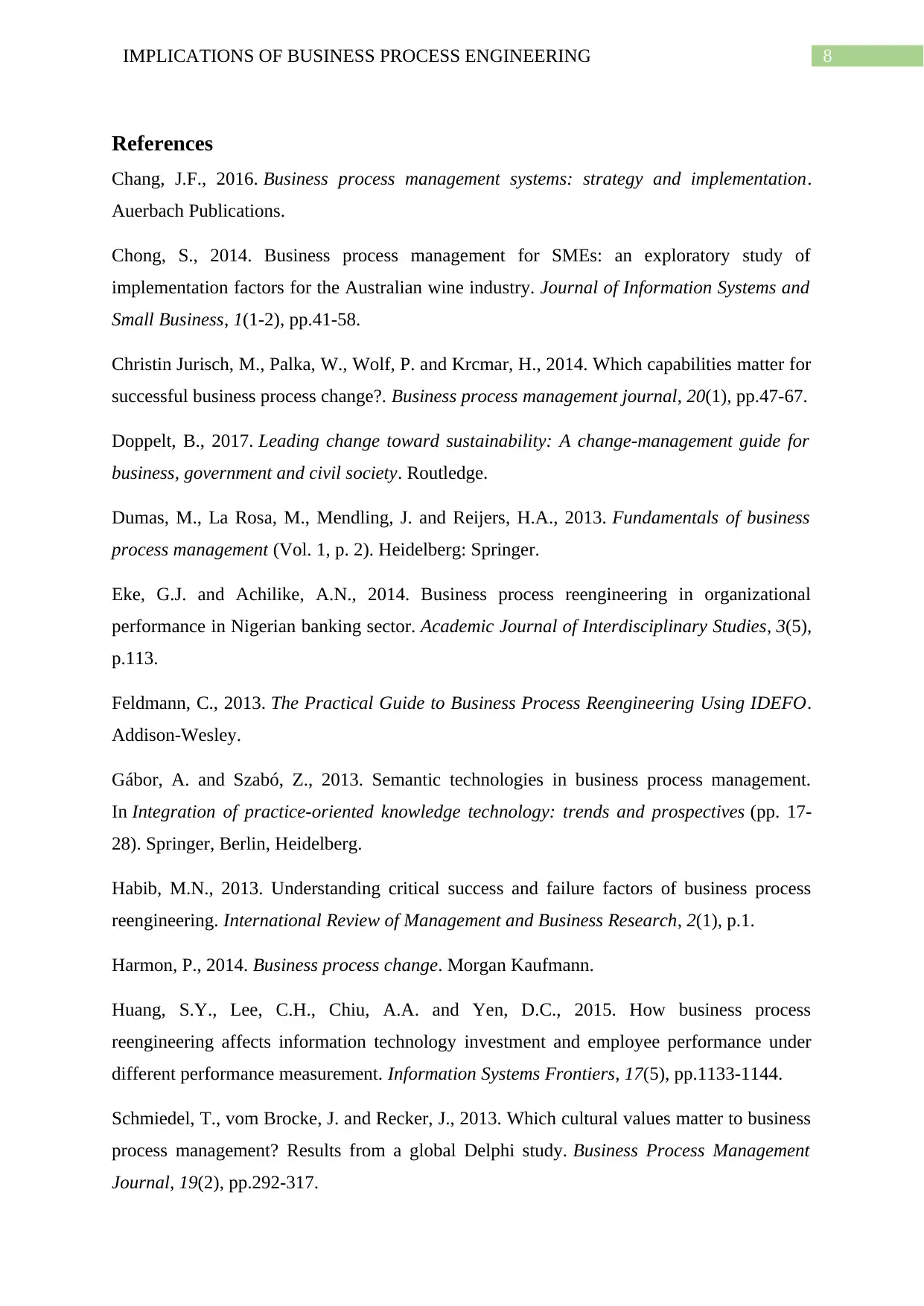
8IMPLICATIONS OF BUSINESS PROCESS ENGINEERING
References
Chang, J.F., 2016. Business process management systems: strategy and implementation.
Auerbach Publications.
Chong, S., 2014. Business process management for SMEs: an exploratory study of
implementation factors for the Australian wine industry. Journal of Information Systems and
Small Business, 1(1-2), pp.41-58.
Christin Jurisch, M., Palka, W., Wolf, P. and Krcmar, H., 2014. Which capabilities matter for
successful business process change?. Business process management journal, 20(1), pp.47-67.
Doppelt, B., 2017. Leading change toward sustainability: A change-management guide for
business, government and civil society. Routledge.
Dumas, M., La Rosa, M., Mendling, J. and Reijers, H.A., 2013. Fundamentals of business
process management (Vol. 1, p. 2). Heidelberg: Springer.
Eke, G.J. and Achilike, A.N., 2014. Business process reengineering in organizational
performance in Nigerian banking sector. Academic Journal of Interdisciplinary Studies, 3(5),
p.113.
Feldmann, C., 2013. The Practical Guide to Business Process Reengineering Using IDEFO.
Addison-Wesley.
Gábor, A. and Szabó, Z., 2013. Semantic technologies in business process management.
In Integration of practice-oriented knowledge technology: trends and prospectives (pp. 17-
28). Springer, Berlin, Heidelberg.
Habib, M.N., 2013. Understanding critical success and failure factors of business process
reengineering. International Review of Management and Business Research, 2(1), p.1.
Harmon, P., 2014. Business process change. Morgan Kaufmann.
Huang, S.Y., Lee, C.H., Chiu, A.A. and Yen, D.C., 2015. How business process
reengineering affects information technology investment and employee performance under
different performance measurement. Information Systems Frontiers, 17(5), pp.1133-1144.
Schmiedel, T., vom Brocke, J. and Recker, J., 2013. Which cultural values matter to business
process management? Results from a global Delphi study. Business Process Management
Journal, 19(2), pp.292-317.
References
Chang, J.F., 2016. Business process management systems: strategy and implementation.
Auerbach Publications.
Chong, S., 2014. Business process management for SMEs: an exploratory study of
implementation factors for the Australian wine industry. Journal of Information Systems and
Small Business, 1(1-2), pp.41-58.
Christin Jurisch, M., Palka, W., Wolf, P. and Krcmar, H., 2014. Which capabilities matter for
successful business process change?. Business process management journal, 20(1), pp.47-67.
Doppelt, B., 2017. Leading change toward sustainability: A change-management guide for
business, government and civil society. Routledge.
Dumas, M., La Rosa, M., Mendling, J. and Reijers, H.A., 2013. Fundamentals of business
process management (Vol. 1, p. 2). Heidelberg: Springer.
Eke, G.J. and Achilike, A.N., 2014. Business process reengineering in organizational
performance in Nigerian banking sector. Academic Journal of Interdisciplinary Studies, 3(5),
p.113.
Feldmann, C., 2013. The Practical Guide to Business Process Reengineering Using IDEFO.
Addison-Wesley.
Gábor, A. and Szabó, Z., 2013. Semantic technologies in business process management.
In Integration of practice-oriented knowledge technology: trends and prospectives (pp. 17-
28). Springer, Berlin, Heidelberg.
Habib, M.N., 2013. Understanding critical success and failure factors of business process
reengineering. International Review of Management and Business Research, 2(1), p.1.
Harmon, P., 2014. Business process change. Morgan Kaufmann.
Huang, S.Y., Lee, C.H., Chiu, A.A. and Yen, D.C., 2015. How business process
reengineering affects information technology investment and employee performance under
different performance measurement. Information Systems Frontiers, 17(5), pp.1133-1144.
Schmiedel, T., vom Brocke, J. and Recker, J., 2013. Which cultural values matter to business
process management? Results from a global Delphi study. Business Process Management
Journal, 19(2), pp.292-317.
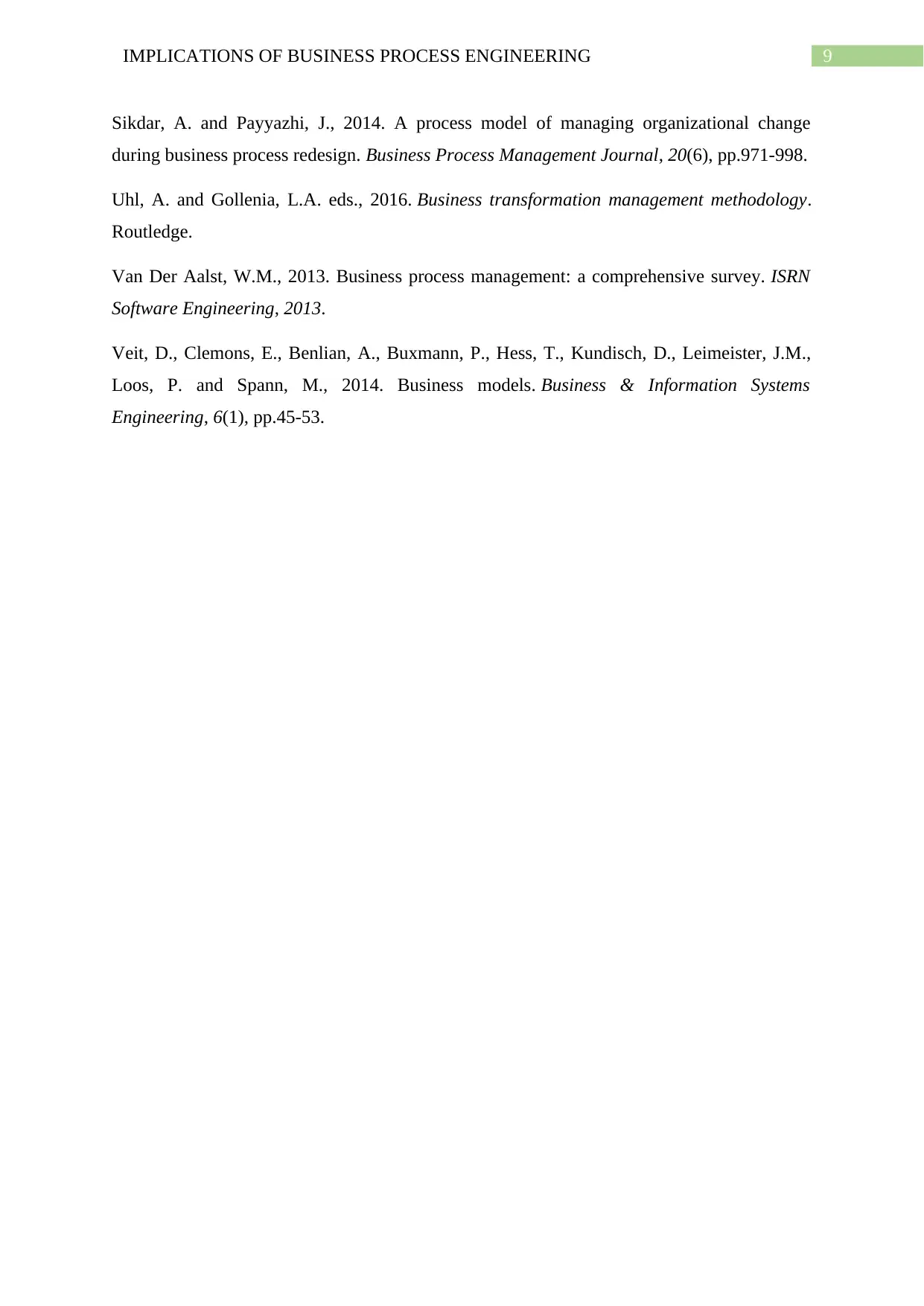
9IMPLICATIONS OF BUSINESS PROCESS ENGINEERING
Sikdar, A. and Payyazhi, J., 2014. A process model of managing organizational change
during business process redesign. Business Process Management Journal, 20(6), pp.971-998.
Uhl, A. and Gollenia, L.A. eds., 2016. Business transformation management methodology.
Routledge.
Van Der Aalst, W.M., 2013. Business process management: a comprehensive survey. ISRN
Software Engineering, 2013.
Veit, D., Clemons, E., Benlian, A., Buxmann, P., Hess, T., Kundisch, D., Leimeister, J.M.,
Loos, P. and Spann, M., 2014. Business models. Business & Information Systems
Engineering, 6(1), pp.45-53.
Sikdar, A. and Payyazhi, J., 2014. A process model of managing organizational change
during business process redesign. Business Process Management Journal, 20(6), pp.971-998.
Uhl, A. and Gollenia, L.A. eds., 2016. Business transformation management methodology.
Routledge.
Van Der Aalst, W.M., 2013. Business process management: a comprehensive survey. ISRN
Software Engineering, 2013.
Veit, D., Clemons, E., Benlian, A., Buxmann, P., Hess, T., Kundisch, D., Leimeister, J.M.,
Loos, P. and Spann, M., 2014. Business models. Business & Information Systems
Engineering, 6(1), pp.45-53.
1 out of 9
![[object Object]](/_next/static/media/star-bottom.7253800d.svg)




